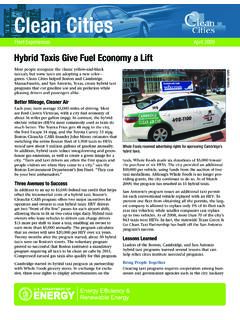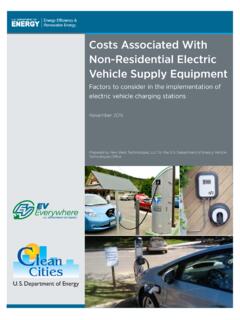Transcription of Electric Vehicle Basics - Energy
1 Electric Vehicle BasicsElectric vehicles (EVs) use electricity as their primary fuel or to improve the efficiency of conventional Vehicle designs. EVs include all- Electric vehicles, also referred to as battery Electric vehicles (BEVs), and plug-in hybrid Electric vehicles (PHEVs). In colloquial references, these vehicles are called Electric cars, or simply EVs, even though some of these vehicles still use liquid fuels in conjunction with electricity. EVs are known for providing instant torque and a quiet driver types of Electric -drive vehicles not covered here include hybrid Electric vehicles, which are powered by a conventional engine and an Electric motor that uses Energy stored in a battery that is charged by regenerative braking, not by plugging in, and fuel cell Electric vehicles, which use a propulsion system similar to Electric vehicles, where Energy stored as hydrogen is converted to electricity by the fuel VehiclesAll- Electric vehicles do not have conventional engines but are driven solely by one or more Electric motors powered by Energy stored in batteries.
2 The batteries are charged by plugging the Vehicle into Electric vehicles are charged by plugging the Vehicle into an Electric power source. Photo courtesy of BrakingRegenerative braking allows EVs to capture Energy normally lost during braking by using the Electric motor as a generator and storing that captured Energy in the at a GlanceEVs run on electricity alone. They are powered by one or more Electric motors and a battery. The battery is charged by plugging the Vehicle into an Electric power source and through regenerative can travel moderate distances on electricity alone. The battery can be charged by plugging into an Electric power source, through regenerative braking, and by the don t have to be plugged in before driving. They can also be fueled solely with conventional fuel. However, they will not achieve maximum fuel economy or take full advantage of their all- Electric capabilities without plugging Electric power source and can also be charged through regenerative braking.
3 All- Electric vehicles produce no tailpipe emissions, although there are life cycle emissions associated with the electricity vehicles typically have shorter driving ranges per charge than conventional vehicles have per tank of gasoline. Most new BEVs are designed to travel about 100 to 400+ miles on a fully charged battery, depending on the model. For context, 90% of all household trips cover less than 100 An all- Electric Vehicle s range varies according to driving conditions and driving habits. Extreme temperatures tend to reduce range because Energy from the battery powers climate control systems in addition to powering the motor. Speeding, aggressive driving, and heavy loads can also reduce Hybrid Electric VehiclesPHEVs use batteries to power an Electric motor and use another fuel, such as gasoline, to power a conventional engine. The batteries are typically charged by plugging the PHEV into an Electric power source, although they can also be charged by the conventional engine and through regenerative have an all- Electric driving range of about 15 to 50+ miles, depending on the model.
4 As long as the battery is 1 National Highway Travel Survey, Department of Transportation, Federal Highway Administration, 2008, f , a PHEV can draw most of its power from electricity for typical daily driving. The engine will then kick in when the battery is mostly depleted, during rapid acceleration, at high speeds, or when intensive heating or air conditioning is required. When running on battery power alone, PHEVs produce no tailpipe emissions. Even when the conventional engine is running, PHEVs typically consume less gasoline and produce fewer emissions than similar conventional vehicles. What EV Models Are Available?Nearly all major Vehicle manufacturers have EV models available, and some have committed to transitioning to selling only EVs by and heavy-duty options are also available for fleet applications. See Considering an EV for fleet-specific considerations.
5 For up-to-date information on available models, use the Alternative Fuels Data Center (AFDC) Vehicle Search tool ( ) or the Find a Car tool on ( ).How Do These Vehicles Fuel Up ?Charging equipment provides electricity to charge EV batteries. The charging unit communicates with the Vehicle to ensure that it supplies an appropriate and safe flow of electricity. There are more than 100,000 publicly available charging outlets and counting across the country. The average range of a light-duty BEV was 260 miles in 2020, with some models exceeding 400 miles. Technological advances such as larger batteries and growing access to charging are increas-ingly addressing range anxiety, or the fear of running out of charge. Learn more about trends in EV charging infrastructure ( ).It may take as little as 20 minutes to fully charge an EV s battery, but charging times vary based on the type or level of charging; the type of battery, its capacity, and how depleted it is; and the capacity of the Vehicle s internal charger (see Charging Options table).
6 Charging units can be installed in residential, fleet, workplace, and public settings. Most EVs come with a 110-volt Level 1 cordset that can be plugged into a typical electrical outlet. For quicker charging, homeowners can install a 240-V Level 2 unit on a dedicated electrical circuit. This can often be done with little or no required electrical upgrades, as most homes have 240-V service for appliances like dryers and Electric ranges. A Level 2 unit can be portable or hard wired into a building and can be purchased for as little as $200. For more information on installing charging equipment, see Charging Infrastructure Procurement and Installation on the AFDC ( ).To make long-distance travel more accessible, the Federal Highway Administration is establishing a network of alternative fueling and charging infrastructure along highway corridors.
7 Designated EV corridors2 supported by DC fast charging stations are under development nationwide. To find public stations, use the Alternative Fueling Station Locator ( ), which is available as an iPhone and Android Types and CostsCharging units are classified according to the rate at which they charge batteries. Two types Level 1 and Level 2 provide AC power to the Vehicle , with the More heavy-duty Vehicle manufacturers are now offering plug-in models for fleets. Photo by Dennis Schroeder, NREL Made SimpleMost EV owners charge at home or at work because charging is more convenient and cost-effective than using public stations. But public equipment is also easy to use. Depending on the station, drivers might use a network card, credit card, phone, cash, or even just enter an account number. There are also free chargers where users can just plug in.
8 An added benefit of going Electric is that electricity prices are less volatile than gasoline and diesel prices, so drivers can more easily forecast their fueling expenses. See a comparison of all fuel prices over time on the AFDC Fuel Prices page ( ). Getting started with an EV is easy thanks to the charging cordset that comes with most vehicles. Photo by Erik Nelsen, NREL s onboard equipment converting AC to DC to charge the batteries. The other type DC fast charging (DCFC) provides DC power directly. Wireless or inductive charging equipment uses an electromagnetic field to transfer electricity to an EV without a cord. Today, this technology is used primarily at higher power levels in heavy-duty applications like transit buses. Some states and utilities offer financial incentives for charging stations; see the AFDC Laws & Incentives page for more information ( ).
9 How Much Do the Vehicles Cost?EVs are generally more expensive than their conventional counterparts. However, lower fueling and maintenance costs can make them a competitive option. For example, Electric drivetrains are more efficient, making BEVs (and PHEVs operating in Electric mode) more than three times as efficient. Electricity is also less expensive than gasoline or diesel on an Energy -equivalent basis. BEV drivers can save as much as $14,500 in fuel costs alone over 15 years (see table: Benefits of Electric -Drive Vehicles).Federal and state tax credits and private and utility rebates may also be available to help offset the cost of EVs. For information on available Vehicle incentives, see the AFDC Laws & Incentives page ( ).To find fuel economy ratings and fuel/ Vehicle cost comparisons among currently available models, visit How Do Their Emissions Compare With Those of Conventional Vehicles?
10 EVs typically produce fewer emissions than conventional vehicles. All- Electric vehicles produce zero tailpipe emissions, and PHEVs produce no tailpipe emissions when in Electric -only mode. Life cycle emissions are generated when fuel or electricity is produced, as well as during the manufacturing of the Vehicle itself. The life cycle emissions of an EV largely depend on how the electricity is generated (and how much a PHEV s engine is being used), and this varies by region. Generally, all- Electric vehicles and PHEVs produce one-third to half the emissions of conventional vehicles, respectively. Regions with high use of renewable Energy will see stronger emissions benefits. See a comparison of emissions by state using the AFDC comparison tool at , all- Electric vehicles produce a third of the emissions of conventional vehicles and PHEVs produce less than half, considering both air pollutants and greenhouse gases.











